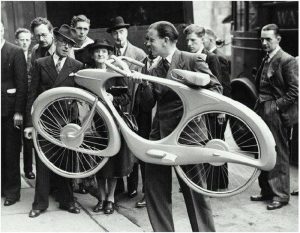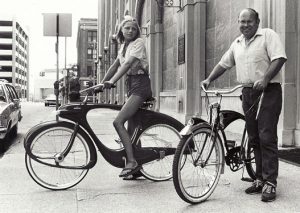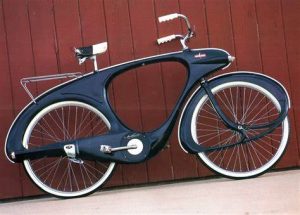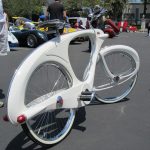
 Today it would be worth about $4750. Would you pay that much for a bicycle? I don’t think I would, but then I don’t suppose I would be buying a bicycle called the Spacelander. Still, if I was, $4750 would be the asking price, or something close to that number. The Spacelander was created by Benjamin Bowden, who was born June 3, 1906. He was a British industrial designer, whose specialty was automobiles and bicycles. He received violin training at Guildhall, and completed a course in engineering at Regent. Bowden designed the coachwork of Healey’s Elliott, an influential British sports car.
Today it would be worth about $4750. Would you pay that much for a bicycle? I don’t think I would, but then I don’t suppose I would be buying a bicycle called the Spacelander. Still, if I was, $4750 would be the asking price, or something close to that number. The Spacelander was created by Benjamin Bowden, who was born June 3, 1906. He was a British industrial designer, whose specialty was automobiles and bicycles. He received violin training at Guildhall, and completed a course in engineering at Regent. Bowden designed the coachwork of Healey’s Elliott, an influential British sports car.
In 1925 Bowden began working as an automobile designer for the Rootes Group. By the late 1930s, Bowden was the chief body engineer for the Humber car factory in Coventry. During World War II, his design of an armored car was used by Winston Churchill and George VI for their protection. In 1945, he left the Rootes Group, and with partner John Allen, formed his own design company in Leamington Spa. The studio was one of the first such design firms in Britain. Bowden designed the body of Healey’s Elliott in 1947. It was the first British car to break the 100 mile per hour barrier. Working with Achille Sampietro who created the chassis, Bowden drew the initial design for the auto directly onto the walls of his house. Unusual…yes, but it worked for him, I guess. Shortly before his departure to the United States Bowden penned a sketch design for a two-seater sports racing prototype, the Zethrin Rennsport, being developed by Val Zethrin. This used the same wheelbase as the short-chassis Squire Sports, and was dressed in a contemporary, streamlined body. This design theme was carried through to his future work on the early Chevrolet Corvette and Ford Thunderbird.
He went on to design the Spacelander in 1946. It was a space-age looking bicycle, that was ahead of its time, since space travel wouldn’t occur for two decades. It’s not that the Spacelander would ever be used in space, but rather the design that seemed space-like. Bowden called the bicycle the Classic. In the early or mid 1950s, Bowden moved to Michigan, in the United States. While in Muskegon, Michigan in 1959, he met with Joe Kaskie, of the George Morrell Corporation, a custom molding company. Kaskie suggested molding the bicycle in fiberglass instead of aluminum, but the fiberglass frame was relatively fragile, and its unusual nature made it difficult to market to established bicycle distributors. Although he retained the futuristic appearance of the Classic, Bowden abandoned the hub dynamo, and replaced the drive-train with a more common sprocket-chain assembly. The new name, Spacelander, was chosen to capitalize on interest in the Space Race. Financial 
 troubles from the distributor forced Bowden to rush development of the Spacelander, which was released in 1960 in five colors: Charcoal Black, Cliffs of Dover White, Meadow Green, Outer Space Blue, and Stop Sign Red. The bicycle was priced at $89.50, which made it one of the more expensive bicycles on the market. Only 522 Spacelander bicycles were shipped before production was stopped, although more complete sets of parts were manufactured. In more recent years, the Spacelander has become a collector’s item…hence the price tag.
troubles from the distributor forced Bowden to rush development of the Spacelander, which was released in 1960 in five colors: Charcoal Black, Cliffs of Dover White, Meadow Green, Outer Space Blue, and Stop Sign Red. The bicycle was priced at $89.50, which made it one of the more expensive bicycles on the market. Only 522 Spacelander bicycles were shipped before production was stopped, although more complete sets of parts were manufactured. In more recent years, the Spacelander has become a collector’s item…hence the price tag.


Leave a Reply